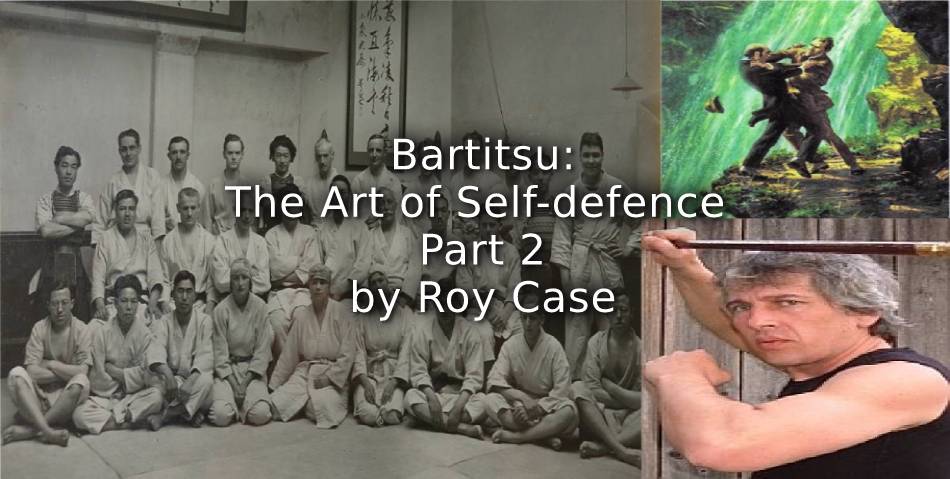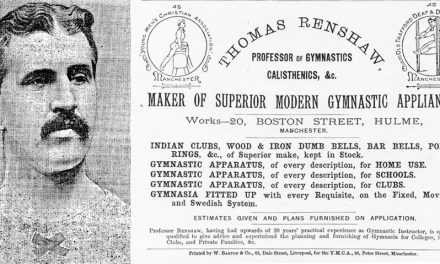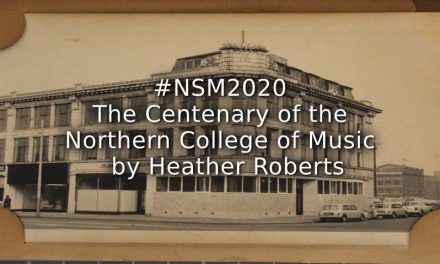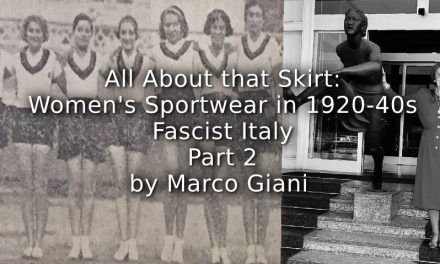Part 1 can be read HERE
In 1913, the Liberal government led by Herbert Asquith, 1st Earl of Oxford and Asquith, KG, PC, KC, FRS [1852-1928] from 1908 to 1916, introduced the so-called ‘Cat and Mouse Act’, during which Suffragette leaders on hunger strikes could be released from prison, allegedly in order to recover their health, and subsequently re-arrested on the original charge. The WSPU responded by establishing an all-woman protection unit referred to as the ‘Bodyguard’, to safeguard fugitive suffragettes from re-arrest. Edith Garrud became the first person to train members of the Bodyguard in the art of jiu-jitsu, and the use of Indian clubs as defensive weapons, at secret locations to avoid police attention. The Bodyguard fought a number of hand-to-hand battles with police officers which were attempting to arrest their leaders, most famously during the so-called ‘Battle of Glasgow’ in March 1914 and two months later during the WSPU ‘Raid on Buckingham Palace’. On several occasions they were able to stage successful escapes and rescues, by making tactical use of disguise and the use of decoys to confuse the police. A number of such incidents were exposed in an unpublished account written by Bodyguard member Katherine ‘Kitty’ Marshall, née Willoughby, [1870-1947] called ‘Suffragette Escapes and Adventures’.
The term ‘Suffrajitsu’ was first coined by an anonymous journalist in March 1914, to describe the martial arts and self-defence methods used by members of the WSPU against the police and other antagonists during demonstrations by the women’s activist organisation known as ‘Women’s Suffrage’. Founded in 1903 by the Manchester political activist, Emmeline Pankhurst [1858-1928], members of the women-only movement engaged in direct action and civil disobedience in their fight for the right to vote in public elections under the banner ‘Votes for Women’.
The Bodyguard was disbanded shortly after the onset of the First World War, when Emmeline Pankhurst decided to suspend militant suffrage action and support the British Government during the crisis.
Edith Garrud continued to work as a teacher of self-defence and jiu-jitsu until 1925 when she retired from public life.
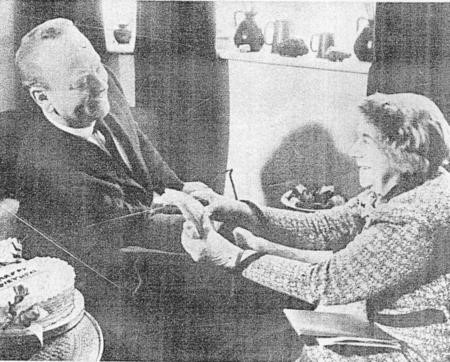
On her 94th birthday in 1966, Edith gave her last interview to the ‘Woman’ magazine, where she demonstrated some of her joint locking techniques to Godfrey Winn [1906-1971, the popular English journalist, columnist, writer and actor. She died in 1971 at the age of 99.
In June 2011, Islington London Borough Council positioned a plaque outside the former home of Edith Garrud in Thornhill Square, and in 2013 her image was included in a sculpture in Finsbury Park bus and tube station. Edith was also the subject of a short documentary in May 2014 screened by BBC1 and presented by the actress Honor Blackman [1925-2020].on the live magazine programme The One Show,
Regular training continued to be held at the Bartitsu Club, where students were taught the basic principles of attack and self-defence systems of jiu-jitsu, French kick-boxing, boxing, and cane-fighting. Instruction typically began with a sequence of 19 century strength and flexibility warm-up exercises. Following which the trainer would generally seek a volunteer to demonstrate methods of surprising and forcibly restraining an aggressor, in order to understand how to properly subdue an opponent. Students would then be encouraged to replicate and practice the training with the help of a partner.
Over a number of years Barton-Wright modified the Bartitsu practice systems, allegedly in order to improve his understanding of the art of self defence, and encourage Bartitsu Club members to study and master each of the four major hand-to-hand combat styles. Based upon essays on the subject delivered by Barton-Wright, it is evident Bartitsu classes placed greatest emphasis upon the cane-fighting system ‘la canne’ at the striking range, and jiu-jitsu at the grappling range. La Savate and boxing were used as an effective smooth transfer between disciplines, or as a first response should the defender not be armed with a walking stick.
According to the columnist Mary Nugent, Barton-Wright introduced an unusual tutorial system in which prospective students were initially required to attend a series of private training sessions before being allowed to join what were perceived as the more dangerous group classes. An anonymous article published in an April edition of ‘The Sketch’ in 1901, suggested these sessions possibly included a type of circuit training when, instead of resting, students would rotate between a number of exercise groups to receive tuition by specialist instructors. Unregulated bouts of sparring were also encouraged incorporating, jiu-jitsu and stick-fighting, along with procedures demonstrating how to effectively use an overcoat as a means of defence.
Perhaps predictably the popularity of Bartitsu began to show signs of diminishing, and the Bartitsu Club almost faded into obscurity. Possibly due to excessive enrolment and tuition fees which led to a decline in Club membership. Seemingly Barton-Wright over estimated the number of wealthy Londoners who shared his interest in self-defence systems, and by mid-1902 the Bartitsu Club was no longer operational, its last recorded activities being a series of touring exhibitions and contests at city venues across England.
However a number of Barton-Wright’s former employees, including Yukio Tani, Sadakazu Uyenishi and Pierre Vigny, developed their own combat sports gymnasiums in London.
Yukio Tani also continued to work as a professional music-hall wrestler, under the management of William Bankier [1870=1949], a magazine publisher and strongman stage performer, who went by the stage-name of ‘Apollo, the Scottish Hercules’, and in 1915-1919 served as ‘King Rat’ for the show business charity the Grand Order of Water Rats. Until the beginning of World War I in 1914, Bankier’s promotional efforts temporarily helped stimulate jiu-jitsu and the martial arts, through the publication of a number of books and magazine articles, and by launching a number of jiu-jitsu academies.
But Bartitsu never recovered to enjoy the prominence it possessed during the lifetime of Barton-Wright, who spent the remainder of his career working as a physical therapist specialising in forms of heat, light, and radiation therapy.
In 1950 he was interviewed by the Japanese master of judo Gunji Koizumi [1855-1965], for an article which appeared in the newsletter of the pioneering Japanese martial arts society Budokwai [The Way of Knighthood Society].
Known as the ‘Father of British Judo’, Koizumi was the founder of Budokwai, which introduced the martial art to the United Kingdom. A judo 8th degree dan, the highest rank in the Judo world being a 10th degree dan, Koizumi helped establish the British Judo Association [BJA], the national governing body for the Olympic sport of judo, and the European Judo Union. In 1965 Koizumi shocked the world of judo when it was revealed he had committed suicide.
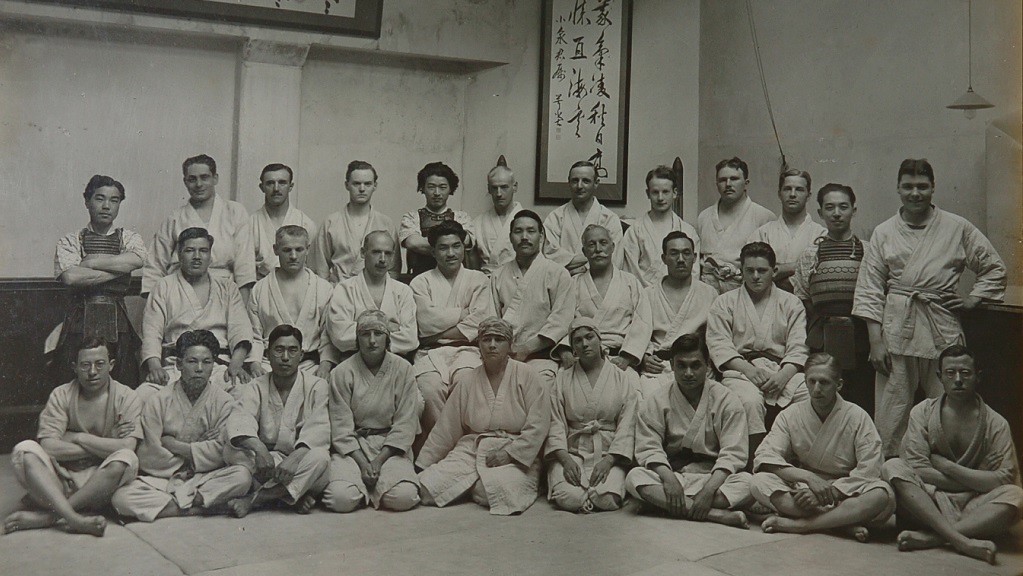
Members of the Budokwai, Lower Grosvenor Place, London – 1922
In 1950 Barton-Wright was presented to the audience at a Budokwai symposium in London as ‘the pioneer of jiu-jitsu in Great Britain’. He died the following year, aged 90, and was buried in Kingston Cemetery, Surrey, in what the martial arts historian Richard Bowen [Born 1926] described as ‘a pauper’s grave’.
Fittingly, in 2007 Bartitsu Society member Phil Giles visited the Kingston Cemetery and placed a marker on the grave behalf of the Society. One of the aims of the Society is to provide a fitting memorial commemorating the work of Barton-Wright, and the Royal Borough of Kingston has agreed that in view of his unique position as a pioneer of martial arts, his grave site should be include as a feature of a historical heritage trail.
Born in Belgravia, ‘Dicky’ Bowen took up judo at the age of 23 and joined the Budokwai where he received tuition from the distinguished coach of the British national judo team, Gunji Koizumi. Along with Percy Sekine [1920-2010], who was unbeaten representing Great Britain in judo tournaments in the 1940s and 1950s, and judo teacher Trevor Pryce Leggett [1914-2000] who taught judo at the Budokwai, and was head of the BBC Japanese Service for 24 years. Pryce was honoured in 1984 for helping introduce Japanese culture to the United Kingdom, when he was inducted into Japan’s Order of the Sacred Treasure [Zuihō-shō], established in 1888 by Emperor Meiji [1852-1912].
In 1956 Bowen represented Britain at the 1st World Judo Championships in Japan. Following which he spent three years training at the Kōdōkan Judo Institute in Tokyo. Founded in 1882 the Kōdōkan Institute is the headquarters of the worldwide judo community. On his return to England, Bowen resumed his former close association with the Budokwai, both as a ‘judoka’, an expert practitioner of the Japanese martial art of judo, and as the Budokwai Vice-President. He also became actively involved with the British Judo Association.
The articles written by Edward Barton-Wright, which were originally published in Pearson’s Magazine in 1899, were rediscovered in the archives of the British Library by ‘Dicky’ Bowen. Many of which were re-released in 2001 on the ‘Electronic Journals of Martial Arts and Sciences’ website. The articles on ‘Self Defence with a Walking Stick’ attracted a significant following and were also reproduced on several other sites. In the same year, Bartitsu stick-fighting demonstrations were included in educational displays performed at the Royal Armouries in Leeds. Originally housed in the Tower of London from the 15 century, the Royal Armouries is one of the oldest museums in the world, and houses the national collection of arms and armour.
Although dormant throughout fot most of the 20 century, Bartitsu might have been completely forgotten were if not for a obscure reference made in 1888 by the writer Sir Arthur Conan Doyle KSU, DL, [1859-1930] in the first of his four mystery novels, ‘A Study in Scarlet’, featuring the fictional private detective Sherlock Holmes, and his classic Victorian gentleman friend and assistant, Dr. John Watson. In which Holmes is portrayed as being skilled in the sport of Bartitsu.
Interest in Conan Doyle’s stories of Sherlock Holmes helped revive the popularity of this particular form of martial arts. And in 1903, in one of his fifty-six short stories, ‘The Adventure of the Empty House’, Sherlock Holmes revealed ‘Baritsu’, as more than once being very useful, helping him survive his encounter with his cunning arch-enemy, Professor Moriarty, on a ledge above the ‘Reichenbach Falls’.
The term ‘baritsu’ is only to be found within the pages of ‘The Adventure of the Empty House’. Since in 1901 the ‘London Times’ published a report on the subject of ‘Japanese Wrestling at the Tivoli’, which covered a Bartitsu demonstration held in London. But the name ‘Baritsu’ was wrongly spelt in the article, and it is probable Conan Doyle used the London Times article as the source of his material and faithfully copied the incorrect spelling.
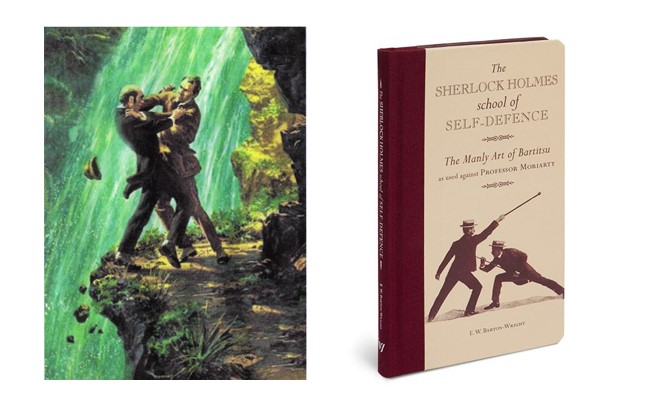
‘Sherlock Holmes School of Self Defence’ by Edward Barton-Wright
A small, explicit guide book, detailing the Manly Art of Bartitsu as used by Sherlock Holmes against Professor Moriarty
Bartitsu continued to enjoy emerging interest, when in the sequel to the 2009 action film Sherlock Holmes the American actor Robert Downey Junior. [Born 1965] and Jude Law [Born 1972] reprised their respective roles as Holmes and Watson in the film Sherlock Holmes: Game of Shadows in 2011, exhibiting Bartitsu skills as the basis of Holmes’ method of combat.
A feature length documentary ‘The Lost Martial Art of Sherlock Holmes’, was released in 2011, narrated by Tony Wolf , who visited numerous locations in Europe, researching the origins and modern revival of Bartitsu as a recreational martial art, and its specific association with the stories of Sherlock Holmes.
In 2002 a number of Bartitsu enthusiasts formed the international Bartitsu Society. Its primary objective being the study of the social history of martial arts during the Victorian and Edwardian eras, and to closely examine the self-defence methods detailed in Barton-Wright’s essay the ‘New Art of Self Defence’ in order to preserve the kick-boxing, jiu-jitsu and stick-fighting styles practiced around the end of the 19 century. Believing that, at the time, the systems taught at the Bartitsu Club were simply ‘work in progress’, and consequently outdated and in need of revival.
Members of the Bartitsu Society began delivering world-wide conferences focussing on the subject of the martial arts in 2003, together with seminars and teaching courses highlighting the characteristic fighting techniques of Bartitsu, and the art at stage combat.
With numerous branches now spread throughout the world, the Bartitsu Society has developed a comprehensive archive of Bartitsu history. In 2005 the Society published ‘The Bartitsu Compendium. History and the Canonical Syllabus’, compiled by Tony Wolf, which details the complete history of Bartitsu. A second volume published three years later, ‘The Bartitsu Compendium. Antagonistics’, was also edited by Tony Wolf and provides information on ‘Neo-Bartitsu’, drawn from the self-defence manuals produced by Barton-Wright, and some of his colleagues.
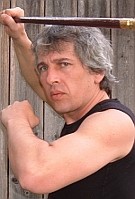
New Zealander, Tony Wolf, was a co-founder of the Bartitsu Society. A professional fight director and stage combat teacher, he began studying the martial art Tae Kwon Do in 1978, and was awarded the rank of black belt in 1983. Following which he began closely examining a wide range of martial arts and combat sports, including Asian and Polynesian techniques, as well as the Afro-Brazilian martial art ‘capoeira’, developed by African slaves in the early 16 century, which combines complex acrobatic manoeuvres with music and dance. Often involving placing the hands on the ground and inverted kicks, the focal point is a flowing, rocking movement, rather than a fixed stance, known as the ‘ginga’.
His action sequences have been featured in around two hundred feature films, theatre and TV productions, including the Lord of the Rings trilogy.
Wolf also developed a specific interest in European ‘folk styles’, and studied the combative methods of the late 1800s, such as kick-boxing, freestyle wrestling and various other historical European martial arts. He taught the martial art Bartitsu at Bartitsu Society conferences around the world, along with Filipino stick and knife-fighting, which developed during an age when people carried knives as a means of defence and settling disputes. Some consider Filipino knife-fighting as the best of the knife-fighting techniques.
Throughout the late 1980s and early 1990s Wolf worked as a self-defence instructor, specialising in self-defence courses for women, and non-violent self-defence for children.
In the autumn of 2006 the Bartitsu Society released a DVD [Digital Video Disc] ‘Bartitsu–the Martial Art of Sherlock Holmes’, a presentation of Bartitsu techniques demonstrated at a seminar organised by the Cumann Bhata Dayton Study Group, on the subject of Western Martial Arts [WMA]. The term WMA is frequently used in the USA to describe modern and traditional close-combat disciplines. The aim of the Cumann Bhata Dayton Study Group is to preserve the various European and early American styles of self-defence and combat fighting, focusing primarily on the 19 and early 20 centuries. Its area of study includes:
- Irish Shillelagh and English Quarterstaff
- Military Sabre, Cutlass, and Bayonet
- Pugilism [Bare Knuckle Boxing]
- Collar and Elbow Wrestling
- Bartitsu
- Bowie Knife and Tomahawk
In 2009 the Bartitsu Society produced a documentary, featuring the art of self-defence as taught by Barton-Wright, which was not released until two years later in 2011. The first international Bartitsu School of Arms seminar was held in London in the autumn of the same year, and the second in Chicago in 2012.
In 2010 a tour of the West Coast of the USA was arranged by the Bartitsu Society, in order to raise the awareness of Bartitsu. It was launched in California and moved on to the Northwest Fencing Academy in Oregon, followed by a visit to a school specialising in traditional Italian fencing, and L’arte d’Armizare [The Art of Arms], a medieval martial art focusing on the sword, dagger, and pole-arm styles employed by medieval European aristocratic warrior classes. The tour then moved on to visit the Academia Duellatoria, in Beaverton, Oregon, a school dedicated to teaching the ‘The Noble Art of Defence’, as described in the surviving manuscripts of the European fencing masters from the time of the fall of the Roman Empire in AD 476, which traditionally marks the start of the Middle Ages. Seminars were also hosted at the School of Acrobatics and New Circus Arts [SANCA] in Seattle. Founded in 2004 SANCA is a leader in the education, safety and instructor training of youth circus arts. The tour then moved on to Vancouver, British Columbia, to visit the Academie Duello, the world’s largest centre for the practice of European sword-play and WMA [Western Martial Arts].
Bartitsu came to the attention of a martial arts instructor in Columbus, Georgia in 2017, who after fully researching its combat methods, founded the ‘Neo-Bartitsu Columbus Academy’ two years later. He began offering regular weekly classes at a martial arts training centre known as Bishop’s Taekwondo Plus, where he taught defence training and escape techniques, and the traditional Korean martial art Taekwondo.
An evolving system, some ‘Neo-Bartitsu’ groups now incorporate improvised weapons within training, believing that holding something during a fight can be of help. A traditional weapon being the gentleman’s walking cane, which although rarely seen used as a fashion accessory these days, is still taught as part of the core Bartitsu syllabus. The French technique ‘La Canne’ occasionally incorporates the Irish shillelagh among its weapons of choice. However the core techniques of true Bartitsu still form the basis of Neo-Bartitsu training..
While Bartitsu may have died in the early 20 century, Edward William Barton-Wright provided a significant legacy for the field of martial arts. He was indeed a man ahead of his time, being the first among Europeans to study Japanese martial arts, and certainly the first to have taught them in Europe and the Americas. And his illustrated articles for Pearson’s Magazine helped popularise self-defence in various newspapers and magazines.
Bartitsu was the first martial art to deliberately combine Asian and European fighting styles, addressing the problems of urban self-defence in an essentially defenceless society. Barton-Wright is remembered as a pioneer of mixed martial arts, in which experts in different fighting styles competed under common rules. receding the phenomenon of the 1990s by a hundred years. And the Bartitsu Club was among the first school of its type to deliver tuition classes in women’s self-defence.
Yet while the world today bears no resemblance to Victorian London, the principles and techniques of Bartitsu remain to this day, an expanding form of self-defence which is remains just as effective, and now practiced throughout the world.
A common question is, ‘Where can I learn more about Bartitsu ?’.
The Bartitsu Club website http://www.bartitsu.club seeks to preserve and promote the art of Bartitsu, and provides a comprehensive directory of existing Bartitsu clubs.
The world famous American actor, martial arts instructor and philosopher, Lee Jun-fan, more commonly known as Bruce Lee [1940-1973], once said,
‘Knowing is not enough, we must apply. Willing is not enough, we must do’.
So whether your interest is to improve your knowledge of the history of martial arts in Victorian England, or enhance your efficiency in the practical skills of self-defence, or simply improve your levels of personal fitness, the martial arts and Bartitsu may turn out to be just the thing for you !
Article of © Roy Case

